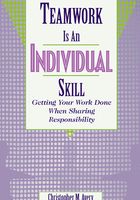
Foreword
IF YOU ARE reading this foreword in a book store, pausing for a moment after having browsed through the business management section, you are probably wondering what makes Teamwork Is an Individual Skill different from the other books on teamwork. Good question! The answer is that this book blends solid theory with real-world experience to create a “how-to” book from which you can start getting value immediately. That’s what makes Teamwork Is an Individual Skill different. But there is more to the story than this….
In my current role as manager of the 3M Meeting Network, I’ve collected a lot of data about teams and teamwork. Everything I see indicates that more and more people are doing more and more of their work as part of a team. In a 1998 survey initiated by 3M, we asked 2,800 people to profile their team-related work over the last ten years. The respondents told us that ten years ago, about 21 percent of their work was done as part of a team. When asked the same question today, those same people told us that close to 50 percent of their work is done in a team. That’s a 250-percent increase over the last decade—an unprecedented change in work style.
Not only is more work being done in teams today, but there are more teams themselves. This is being driven by business trends that are happening both within and between companies. Within companies we see internal groups produced by reducing levels of management hierarchy and pushing decision making down to lower levels. We read about cross-functional and cross-organizational teams and, more recently, about downsizing, or “right-sizing” (the euphemism for doing more work with fewer people) companies. These movements cause workers to wear more hats and assume more roles. The days of one person working within the comfortable bounds of an isolated, well-defined domain is almost ancient history. We are all performing multiple roles, and we must work with other people to create a whole.
We also see increased partnering and alliances between companies. The trend toward just-in-time (JIT) manufacturing, for instance, which creates tighter supplier-manufacturer relationships and dependencies, is a good example. People are paying greater attention to supply chain management, which creates tighter interdependencies between companies that are working together to get products out the door. These factors, along with the increasing numbers of joint ventures and mergers, are all drivers of collaboration and team-related activity. Whether it occurs within companies or between companies, teaming and teamwork is the mechanism—the engine—by which work is getting done today.
My role at 3M resembles that of a circus ringmaster. What I do is keep things going in different circles around me. I keep multiple—often unrelated—projects moving while watching for breakdowns and putting out the occasional fire. In my case, exercising teamwork as an individual skill means I have to use my personal skills to keep things moving.
Only rarely can you or I control the complement of resources available to us. And controlling other people is an illusion. So what are we left with? Our own behavior. That’s it. The question then becomes: “What are the behaviors and skills we can learn and exhibit that will make our teams more likely to succeed?” This is a book about personal skills development. It’s a how-to book. Christopher Avery’s idea is that we can each learn how to be more effective in any work environment.
In this book Avery weaves together two different perspectives or worlds. The first world is the theoretical world of research on teamwork, group dynamics, management, and personal effectiveness.
The second world is the world of work. Christopher actually knows what people have to face every day in their work lives. He has read more about this stuff than anybody I know, and he also teaches it in his practice as an advisor to business. He has taken these concepts and academic theories and put them to the test as a trainer and a consultant. Working directly with people at the highest and lowest levels of organizations for the last decade has produced in him an insight that is in short supply in the business press. He knows from first-hand experience the problems people run into concerning team effectiveness, the expectations placed on them, and the lack of adequate resources. Christopher knows how to make these ideas about teams work for people. It’s weaving together these two worlds, the academic world and the work world, that gives him a unique voice. I recommend you listen to him now.
Reading Teamwork Is an Individual Skill can supply the edge you need not just to survive the work week, but to thrive in it.
MICHAEL BEGEMAN,Manager
3M Meeting Network